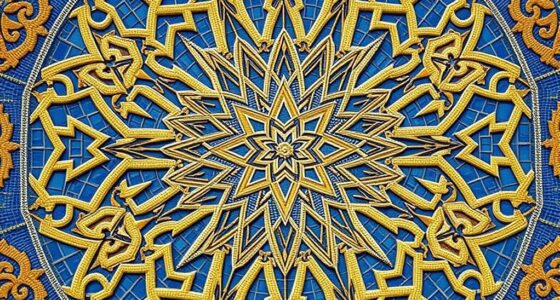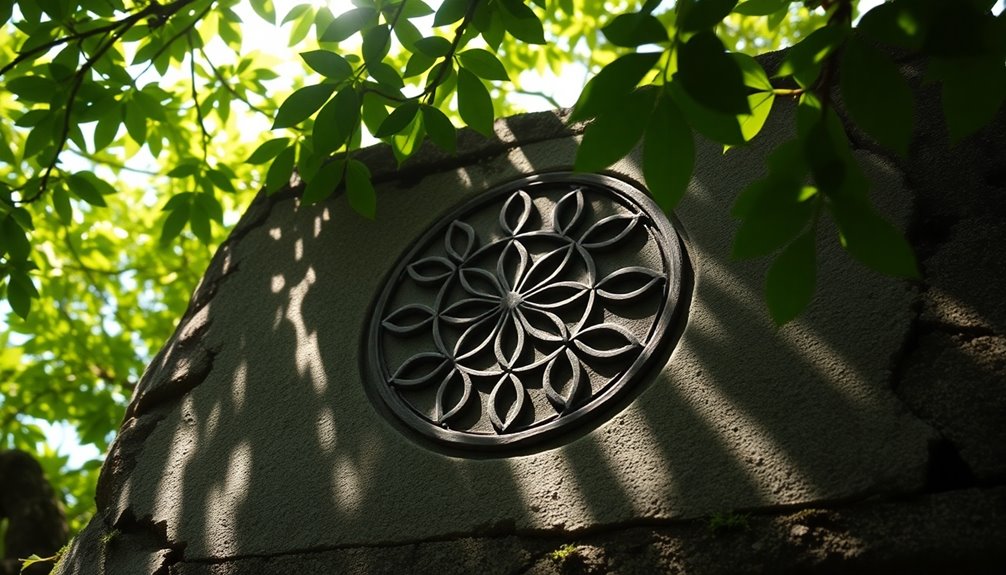The Golden Ratio, or Φ, appears often in nature’s patterns—spirals, shells, and plant arrangements—suggesting it might be a universal blueprint guiding growth and form. Many believe that natural structures favor this ratio for efficiency and beauty, hinting at an underlying code in the universe. While some see it as a coincidence, its consistent presence hints at deeper significance. Keep exploring to uncover how this fascinating ratio influences the world around you.
Key Takeaways
- Φ frequently appears in natural patterns like shells, plant spirals, and galaxy formations, indicating a potential universal presence.
- The Fibonacci sequence, closely linked to Φ, underpins many biological structures and growth processes.
- Historically, Φ has been intentionally used in art and architecture to achieve harmony and aesthetic appeal.
- The consistent occurrence of Φ suggests it may serve as a fundamental code governing natural development and form.
- While some view Φ as a universal pattern, others see its appearance as coincidental or perceptually driven.

Have you ever wondered why certain patterns in nature seem so perfectly balanced? One of the most intriguing explanations lies in the golden ratio, often denoted as Φ (phi). This number, approximately 1.618, isn’t just a mathematical curiosity; it’s a fundamental element that appears repeatedly in natural forms, from the spirals of shells to the branching of trees. Its unique mathematical properties make it stand out, especially because it’s closely linked to the Fibonacci sequence, where the ratio of successive numbers converges to Φ. This link suggests a natural tendency for growth patterns to align with this ratio, creating structures that are both efficient and aesthetically pleasing. Because of these properties, many scientists and mathematicians have long believed that the golden ratio could serve as a universal code embedded in the fabric of nature. Additionally, the natural occurrence of Fibonacci numbers further supports the idea that Φ plays a key role in biological development and structural design. Historically, the applications of the golden ratio extended beyond mere observation. Ancient Greek architects and artists, like Phidias, deliberately employed Φ to shape monuments and sculptures, believing it embodied harmony and beauty. The Parthenon is often cited as an example, with its proportions allegedly reflecting this divine ratio. Over centuries, mathematicians studied its properties, discovering that Φ has unique algebraic qualities—being an irrational number with a simple continued fraction and fascinating self-similarity. These mathematical properties make it a natural candidate for describing growth and form, not just in art but also in biological systems. Its presence in natural patterns prompted many to see it as more than coincidence—possibly a fundamental principle guiding the development of life and the universe. When you look closely at nature, the golden ratio’s influence seems almost undeniable. The spirals of sunflower seeds, the arrangement of leaves around a stem, and even the spiral galaxies all exhibit ratios close to Φ. These observations lead to the question: Is the golden ratio a universal code that nature follows, or is it simply a human tendency to find patterns? Some scientists argue that natural selection favors structures that optimize space, strength, or efficiency, and that these optimal designs often align with the mathematical properties of Φ. Others believe its appearances are more coincidental or a result of our perception’s preference for harmony. Regardless of the debate, what’s clear is that this ratio’s mathematical properties and historical applications reveal a deep connection between mathematics, art, and the natural world. It’s as if nature, consciously or unconsciously, follows a blueprint that reflects the elegance and order embedded in Φ.
Frequently Asked Questions
Does the Golden Ratio Appear in Human Anatomy?
You might notice the golden ratio in human anatomy through body symmetry and facial proportions. It often appears in the way your features align, like the distance between your eyes or the shape of your face. While not perfectly consistent, many artists and scientists find that these proportions tend to follow the golden ratio, giving your body and face a natural harmony that’s aesthetically pleasing and balanced.
Can the Golden Ratio Be Used for Architectural Design?
You can definitely use the golden ratio in architectural design. Historically, architects have applied it to create harmony and aesthetic appeal. Modern interpretations see it as a tool for proportion and balance, guiding the placement of elements in buildings and spaces. By incorporating the golden ratio, you can achieve designs that feel natural and pleasing, connecting past practices with contemporary architecture for visually compelling results.
How Is the Golden Ratio Related to Fibonacci Sequences?
You see, the golden ratio relates directly to Fibonacci sequences through mathematical patterns. As you progress through the Fibonacci sequence, the ratio of consecutive numbers approaches Φ, or the golden ratio. This sequence relationship reveals how complex natural patterns and structures often follow these mathematical patterns, making the golden ratio a key link between nature’s designs and mathematical harmony. You’ll find this connection fascinating in understanding natural growth and form.
Are There Any Scientific Controversies Surrounding Φ’S Significance?
Some skeptics scrutinize the significance of φ, sparking scientific skepticism and stirring mathematical debates. You might wonder if this divine proportion is truly a universal code or just a mathematical marvel. Critics claim that the golden ratio’s appearances are often overstated or coincidental, challenging the idea that it governs natural or aesthetic phenomena. While many celebrate its beauty, the ongoing debates remind you that science always seeks solid, scrutinized truths.
Is the Golden Ratio Found in Microscopic Structures?
You might wonder if the golden ratio appears in microscopic patterns and cellular architecture. In fact, studies show that some biological structures, like shells and plant arrangements, exhibit this ratio, suggesting it influences cellular organization at small scales. While not universal, the golden ratio can be found in certain microscopic patterns, indicating that nature sometimes follows this mathematical principle even at the cellular level.
Conclusion
You start to notice the golden ratio everywhere—hidden in shells, galaxies, and flower petals—almost as if nature’s secret code whispers itself into existence. It’s a coincidence, or maybe more, a pattern that seems to guide the universe’s design. As you explore, you realize that this divine proportion isn’t just a quirk; it’s a universal rhythm, a subtle reminder that beauty and order intertwine, waiting quietly for you to observe and understand their silent message.











